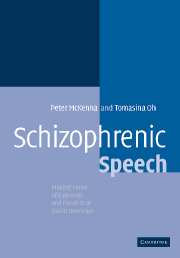Book contents
- Frontmatter
- Contents
- Preface
- 1 Describing schizophrenic speech
- 2 Thought disorder as a syndrome in schizophrenia
- 3 The differential diagnosis of thought disorder
- 4 Thought disorder as a form of dysphasia
- 5 Thought disorder and communicative competence
- 6 Thought disorder as a dysexecutive phenomenon
- 7 The dyssemantic hypothesis of thought disorder
- 8 Some conclusions and a few speculations
- References
- Index
7 - The dyssemantic hypothesis of thought disorder
Published online by Cambridge University Press: 19 August 2009
- Frontmatter
- Contents
- Preface
- 1 Describing schizophrenic speech
- 2 Thought disorder as a syndrome in schizophrenia
- 3 The differential diagnosis of thought disorder
- 4 Thought disorder as a form of dysphasia
- 5 Thought disorder and communicative competence
- 6 Thought disorder as a dysexecutive phenomenon
- 7 The dyssemantic hypothesis of thought disorder
- 8 Some conclusions and a few speculations
- References
- Index
Summary
If the dysexecutive theory of thought disorder can be said to have a psychological rival, it is the idea that the symptom reflects some kind of disturbance in semantic memory. This approach has a longer history than the dysexecutive theory; in fact its origins go back to a time when the term semantic memory did not exist. Since the ‘semantic’ of semantic memory refers to meaning, it also has obvious points of continuity with the theme of semantic abnormality which emerged from the consideration of linguistic and pragmatic abnormalities in Chapters 4 and 5. The theoretical construct of semantic memory even comes with a simple operational process, malfunction of which seems almost tailor-made for giving rise to disorganisation of speech. This process is spreading activation, and the malfunction is the so-called semantic hyperpriming theory of thought disorder.
This chapter could be just about semantic hyperpriming. There is certainly a sizeable enough body of experimental evidence devoted to it. But increased semantic priming was not the first, nor the last, of what might be termed the dyssemantic hypotheses of thought disorder. As the ‘dys’ has meant quite different things in these theories, and since semantic memory is itself a somewhat fragmented concept – which has drawn on linguistics and computer science and even Aristotlean philosophy, as well as psychology and neuropsychology – the appropriate place to begin is with an account of what semantic memory is believed to be.
- Type
- Chapter
- Information
- Schizophrenic SpeechMaking Sense of Bathroots and Ponds that Fall in Doorways, pp. 146 - 171Publisher: Cambridge University PressPrint publication year: 2005

